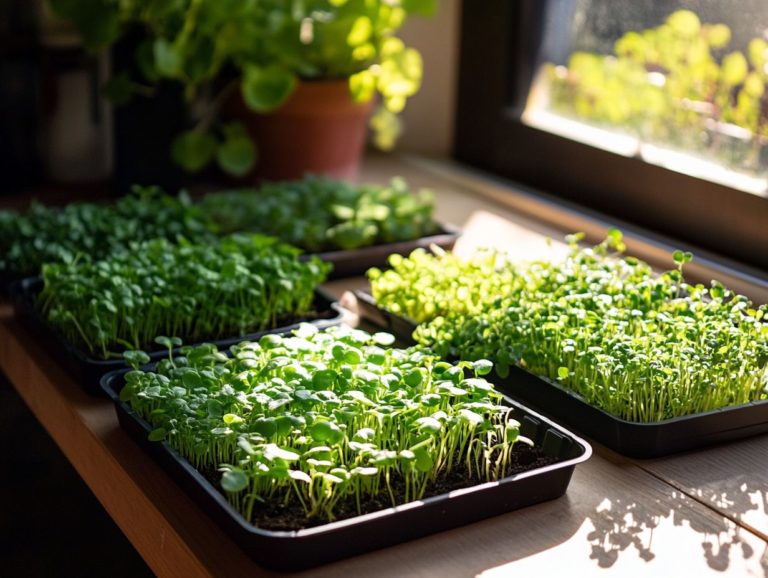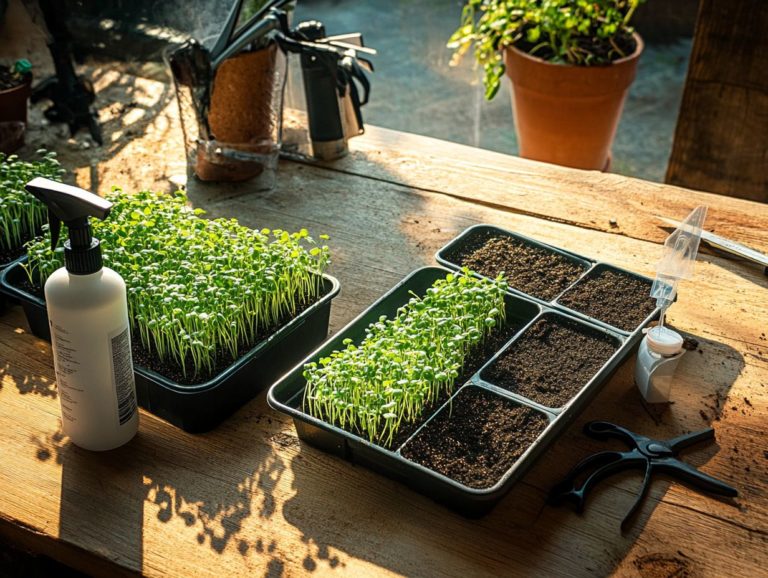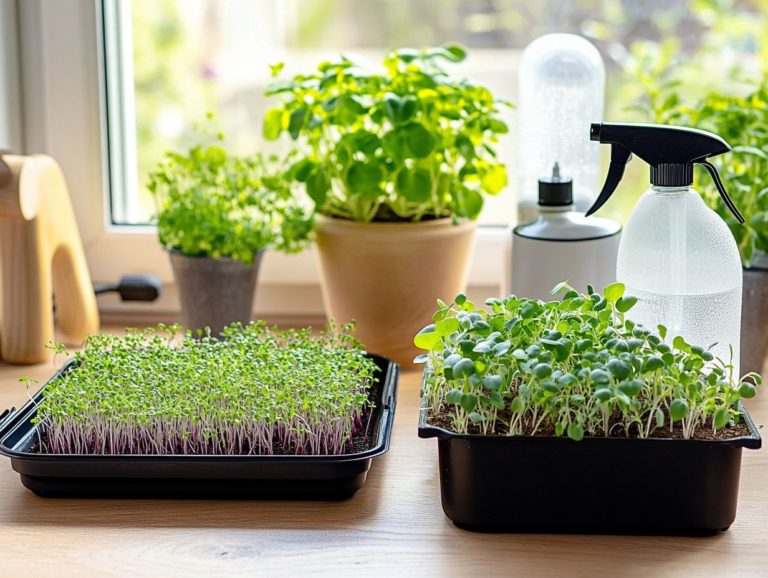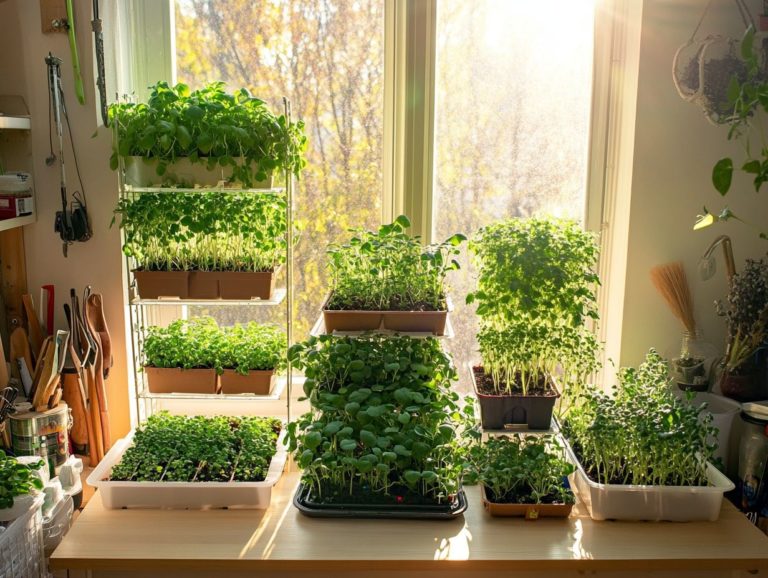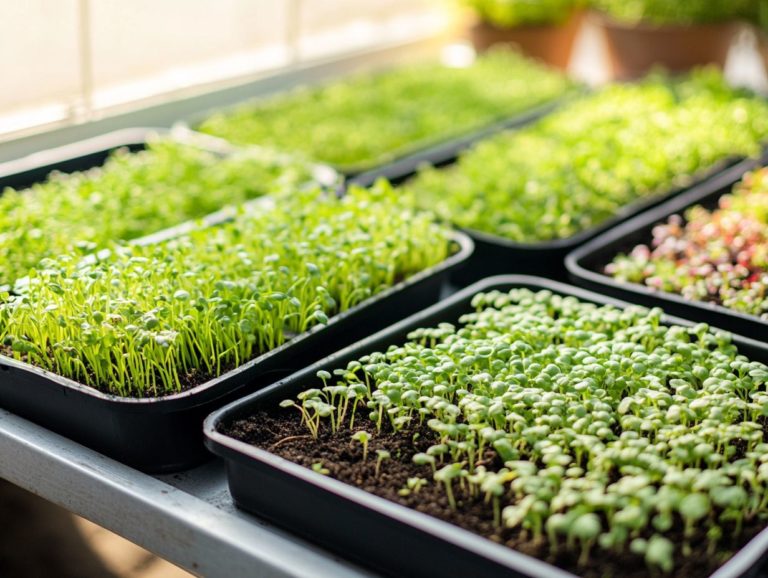Understanding the Costs of Microgreen Supplies
Microgreens are tiny, nutrient-dense plants that elevate your dishes with vibrant flavors and textures while delivering impressive health benefits. In this article, you’ll discover what microgreens are and how they play a vital role in culinary practices. You’ll explore the advantages of growing them yourself, including their exceptional nutritional value and positive impact on the environment.
We delve into the factors that influence the cost of microgreen supplies and offer practical tips to save money while cultivating these delightful greens. Whether you’re an experienced gardener or a curious novice, there s valuable insight here for everyone!
Contents
- Key Takeaways:
- What are Microgreens?
- The Benefits of Growing Microgreens
- Factors Affecting the Cost of Microgreen Supplies
- Ways to Save on Microgreen Supplies
- Frequently Asked Questions
- What are the main setup costs associated with growing microgreens?
- How much do microgreen seeds typically cost?
- Do I need to invest in special lighting equipment for growing microgreens?
- Are there any ways to reduce the costs of microgreen supplies?
- Are there any hidden operational costs associated with growing microgreens?
- Do I need to use organic certifications for growing microgreens?
Key Takeaways:
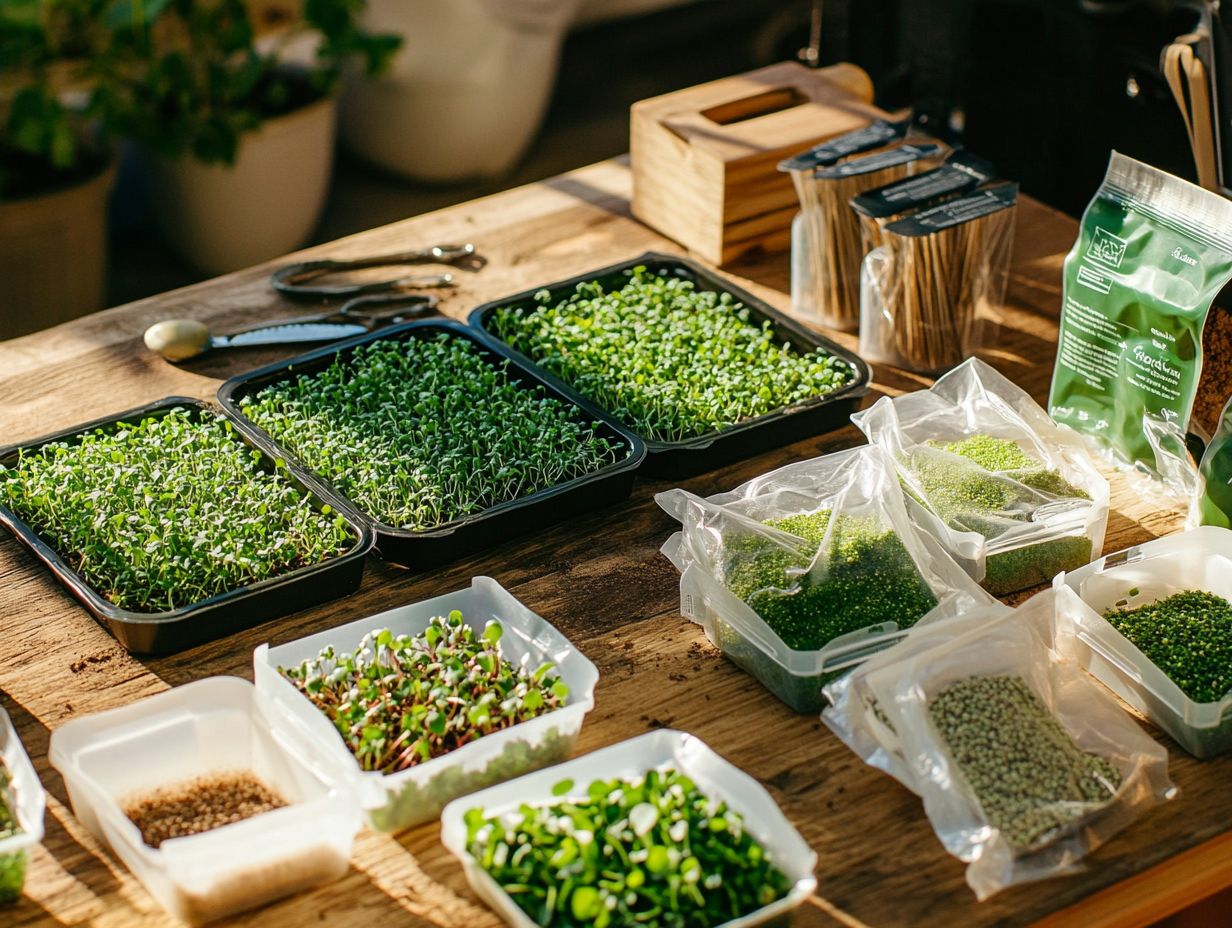
- Microgreens are young edible plants that are easy to grow at home and packed with nutrients.
- Understanding seed selection and growing mediums can help you save money on microgreen supplies.
- By utilizing DIY options, buying in bulk, and exploring alternative growing methods, you can significantly reduce costs and enjoy these nutritious greens!
What are Microgreens?
Microgreens are young edible plants harvested right after their first true leaves, known as cotyledons, appear. These tiny powerhouses burst with flavor and nutrients, making them a prized ingredient in many culinary creations found in restaurants, farmer’s markets, and grocery stores.
Popular varieties include China Rose radish and other nutrient-dense options that cater to the rising demand for health-conscious food and sustainable agriculture, especially in urban hubs like San Francisco.
Definition and Uses
Microgreens have captivated the culinary world with their vibrant flavors and stunning visual appeal. These tiny greens are not just a pretty garnish; they provide a remarkable nutritional boost, often containing more vitamins and minerals than fully matured plants.
Culinary enthusiasts and professional chefs alike embrace the versatility of microgreens, incorporating them into salads, garnishes, sandwiches, and even smoothies. Their delightful range of flavors from spicy to sweet adds a vibrant burst of color and freshness to any dish.
Health-conscious individuals are particularly drawn to these nutrient-dense powerhouses, rich in antioxidants and beneficial phytonutrients. It s no wonder microgreens are considered an excellent choice for enhancing overall wellness!
The Benefits of Growing Microgreens
Growing microgreens offers numerous advantages, including their exceptional nutritional value, which often exceeds that of mature vegetables. They are also known for their minimal environmental footprint and rapid growth cycles, making them an attractive option for anyone interested in cultivation.
Nutritional Value and Environmental Impact
Microgreens are celebrated for their exceptional nutritional profile, often containing higher levels of antioxidants and essential nutrients than their fully grown counterparts.
For instance, varieties such as red cabbage and broccoli microgreens are particularly rich in vitamins C, E, and K, along with vital minerals like calcium and iron. They are formidable additions to any diet!
Beyond health benefits, these tiny greens also offer significant environmental advantages. They require considerably less water and space than traditional crops, thriving in compact areas making them perfect for urban farming initiatives.
Studies show that growing microgreens can use up to 90% less water than conventional agriculture, promoting sustainable food production in regions facing water scarcity.
Are you inspired to grow your own microgreens? Consider starting your own garden today and enjoy the myriad of benefits they offer!
Factors Affecting the Cost of Microgreen Supplies
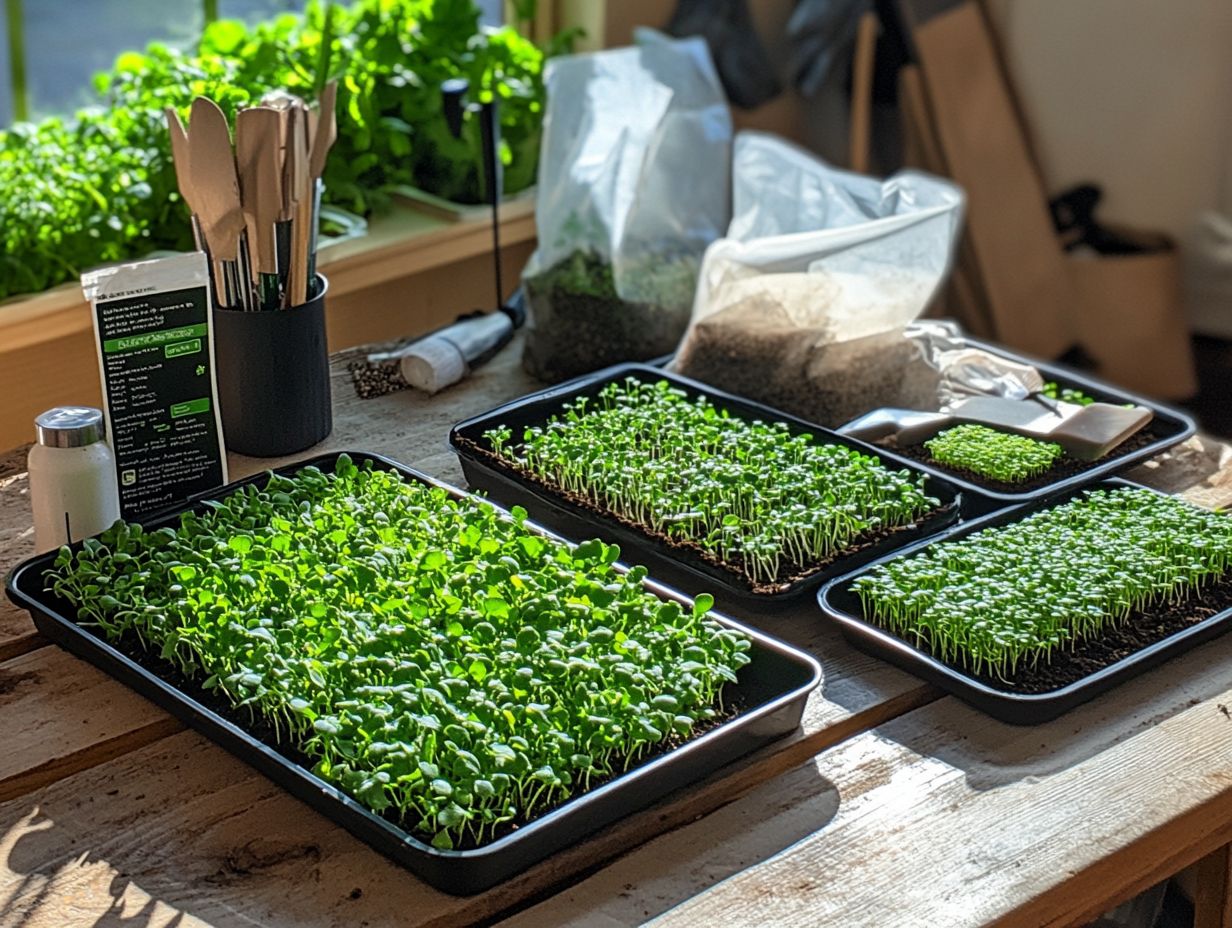
Numerous factors shape the costs related to microgreen supplies. These include initial setup expenses, ongoing operational costs, and the demand for these nutrient-dense edible plants across various markets.
Seed Selection
Choosing the right seeds is essential for profitable microgreen cultivation. Different varieties come with unique growth rates and market prices.
Consider sustainability practices that appeal to environmentally conscious consumers. Factors like seed source, organic certification, and pesticide usage are crucial for attracting buyers who prioritize eco-friendly products.
By understanding consumer preferences regarding taste, texture, and nutritional benefits, you can select the most lucrative varieties for your market. Investing in high-quality seeds not only lays the groundwork for robust growth but also enhances your profitability, making it vital for long-term success in the industry.
Growing Medium
Your choice of growing medium greatly impacts the health of your microgreens. It influences nutrient absorption and overall growth.
You have various options, from soil-based mixtures to hydroponic systems. Each offers its advantages and challenges. For example, soil blends can be budget-friendly and foster beneficial microbes. In contrast, soilless mediums like coconut coir or peat moss may improve drainage and aeration, although they often require a higher initial investment.
Recognizing the balance between cost and efficiency in providing nutrients is crucial for aspiring farmers. The right medium can lead to faster germination times and healthier plants, significantly impacting both yield and profitability.
Equipment and Tools
Choosing the right equipment is vital for growing microgreens. It directly affects your setup and operating costs.
The tools you select optimize the growing environment for healthy, rapid growth. Using trays designed for microgreens enhances drainage and aeration, resulting in better germination rates and a higher yield.
A reliable grow light provides the necessary spectrum and intensity to promote robust growth without significantly increasing energy costs. Implementing aeroponic or hydroponic systems can further streamline your operations, reducing both labor and waste.
By prioritizing quality tools, you create a smoother workflow and cultivate an environment that fosters growth, maximizing your returns.
Ways to Save on Microgreen Supplies
Unlock cost-effective strategies to source your microgreen supplies and watch your profits soar! This opens up opportunities for exploring DIY options, making bulk purchases, and considering alternative growing methods, all of which can elevate your growing experience and financial success.
DIY Options
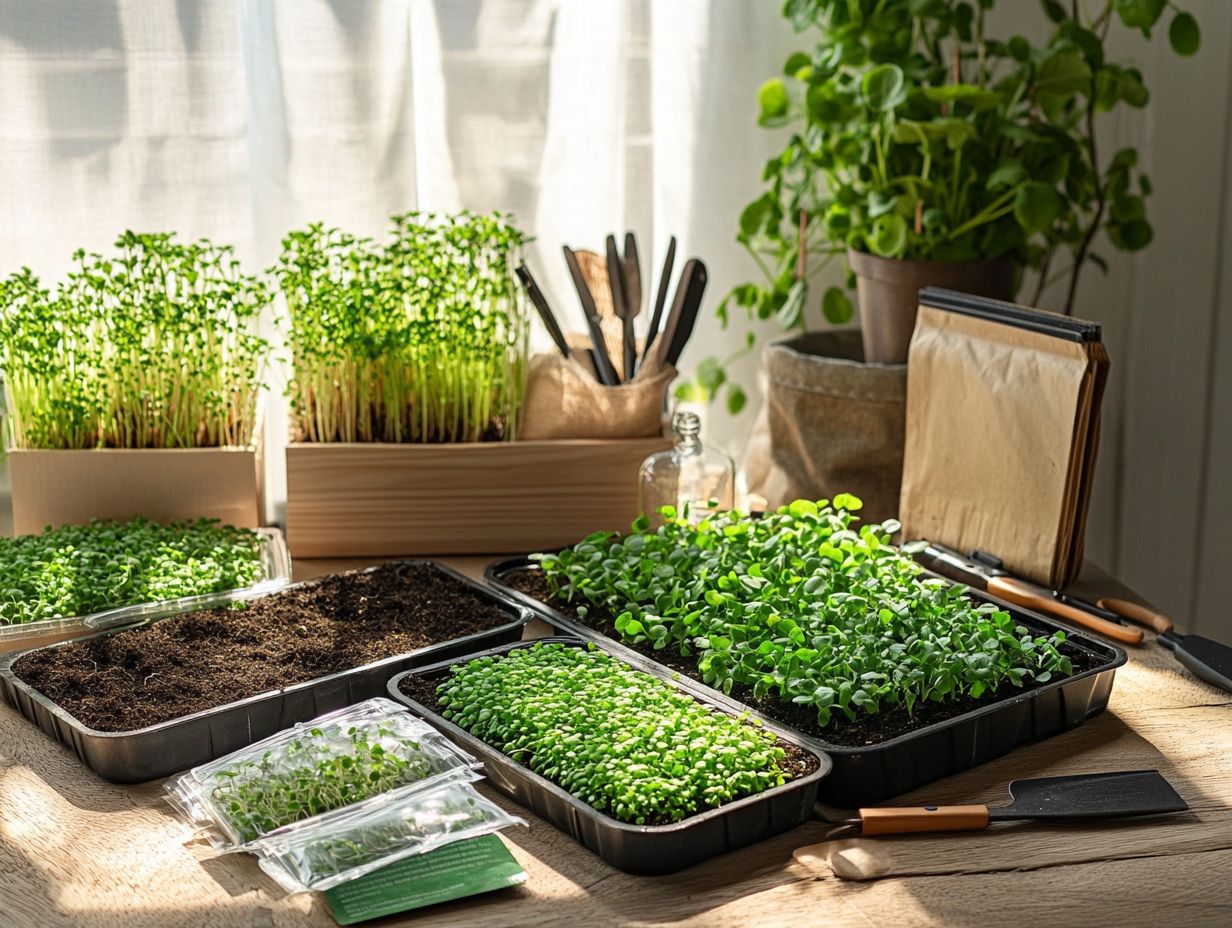
Exploring DIY options for growing microgreens saves you money and aligns with a more sustainable gardening approach.
Crafting homemade trays from recycled containers or repurposed materials allows you to cultivate these nutrient-dense greens while minimizing your financial investment. Pair this strategy with organic growing mediums like coconut coir or compost, creating an ideal environment for thriving microgreens.
These techniques significantly reduce reliance on costly pre-packaged products, making it accessible for anyone to embark on their own microgreen gardening journey. Plus, growing microgreens at home opens the door to experimenting with various varieties, allowing you to discover new flavors and nutritional profiles all while keeping your expenses in check. To understand more about the financial aspect, check out the cost of growing microgreens.
Buying in Bulk
Buying supplies in bulk can yield significant cost savings for microgreen growers. This strategy can enhance profitability.
Investing in larger quantities of seeds, growing mediums, and equipment often unlocks discounts not available for smaller purchases. For example, buying organic soil in five or ten-bag bundles lowers the per-unit price.
Buying seeds in bulk guarantees a steady supply for your projects. It also reduces how often you need to reorder.
Over time, these savings improve your profit margins. This makes it easier to reinvest in your business or expand your product offerings.
Alternative Growing Methods
Exploring alternative growing methods like vertical farming can help you optimize space and maximize yield. These techniques also cut costs.
In addition to vertical farming, consider hydroponics and aquaponics. Hydroponics uses nutrient-rich water for year-round production and reduces reliance on soil.
Aquaponics combines fish farming with plant cultivation. This creates a system where both benefit, conserving water and enhancing efficiency.
For instance, urban farms in New York use these methods to minimize food miles and supply fresh produce to local markets.
Frequently Asked Questions
What are the main setup costs associated with growing microgreens?
You’ll need to budget for seeds, growing media, trays, lighting, and utilities like water and electricity.
How much do microgreen seeds typically cost?

Prices vary by seed type and supplier. Generally, one pound costs between $10 and $25.
Do I need to invest in special lighting equipment for growing microgreens?
Yes, microgreens need adequate light to thrive. You can use natural sunlight or artificial options like fluorescent or LED lights.
Are there any ways to reduce the costs of microgreen supplies?
You can buy seeds in bulk for discounts. Reusing containers for each batch can save money too.
Yes, consider costs for water, electricity, and other utilities needed for growth. Factor these into your expenses.
Do I need to use organic certifications for growing microgreens?
No, organic seeds aren’t a must for growing microgreens. However, if you want to sell them as organic, using organic seeds is essential.

